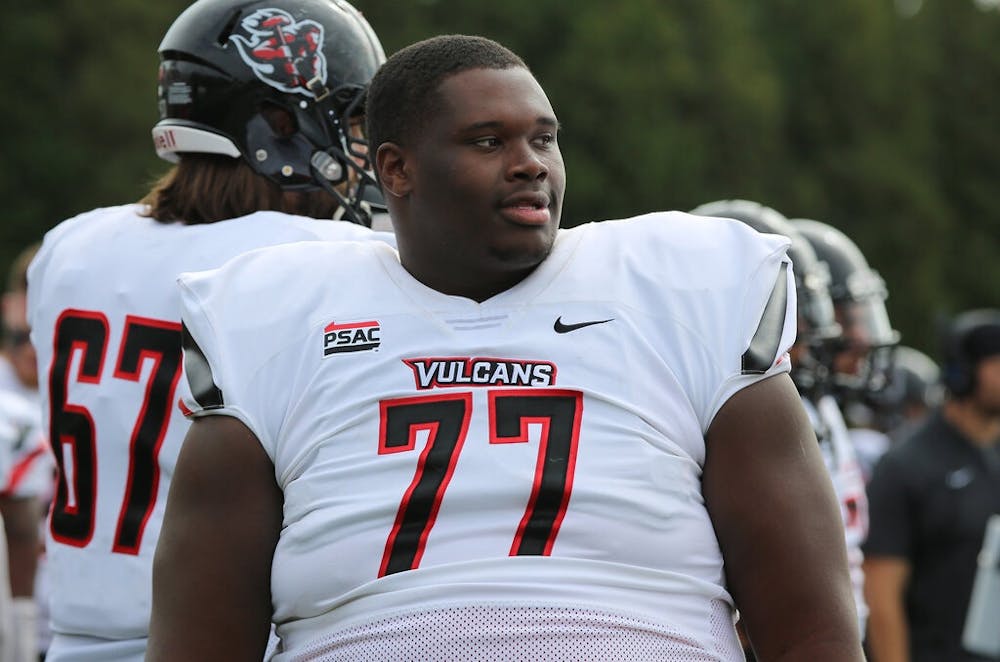
Jamain Stephens Jr. was a prominent figure at California University of Pennsylvania (Cal U), a small university in southwestern Pennsylvania.
Stephens played defensive tackle at Cal U and for a good reason: he was 6 feet 3 inches tall and weighed in at about 350 pounds. When he was in high school, Stephens had to reach out to the Pittsburgh Steelers to obtain size 19 cleats to fit his feet.
Although Stephens was large in stature, his personality was known to overshadow his size, brightening the days of everyone he knew.
On campus, everyone knew Stephens for being the first person to reach out to a new recruit. A professor would count on him to liven up discussions when classes dragged on in the evenings. He often would play intramural basketball games, round up friends for Krispy Kreme runs and return home to mentor children from his community. Both on and off the field, Stephens had a tremendously positive impact on everyone around him.
Stephens’ death left many people in his community shaken earlier this month when the college senior passed away unexpectedly from a blood clot while in the hospital receiving treatment for the coronavirus (COVID-19) and pneumonia. But his death has also shaken foundations of the college sports landscape, as he is the first football player to die from contracting the virus.
Many universities nationwide have taken steps to protect their student-athletes from COVID-19 by postponing or canceling fall sports; Hopkins promptly canceled all fall and winter sports. Cal U, which plays at the National Collegiate Athletic Association Division II level, followed this precedent.
On the other hand, schools in the Division I realm are attempting to salvage money lost from television revenue and big-ticket sales.
The Big Ten Conference announced two weeks ago that it would begin playing football in October, going back on an initial decision to wait until next year. The Pac 12 Conference then also decided to bring football back.
College football stadiums across the country are filling up, with the big-name leagues like Southeastern Conference and Big 12 Conference restarting over the past couple of weeks. Students are filing into the stadiums with varying degrees of adherence to mask rules and social distancing guidelines. But as long as money is being brought in, there seems to be no length that they won’t go to in the name of keeping football alive.
The rationale for playing during this pandemic is that young athletes who might spread the virus have a low mortality rate for their age bracket. However the virus has other harmful side effects that can impact athletes' health for the rest of their lives. Studies of the virus have also shown it disproportionally affects Black and Latinx people and those with large body mass indexes: like many offensive and defensive linemen.
Cases are not few or far between in college sports right now. The Louisiana State University head football coach Ed Orgeron said two weeks ago that "most" of his roster has contracted the virus. The lack of concern for the virus in football locker rooms is frightening.
With the virus continuing to spread across the country, it is impossible to think that these football teams will remain unaffected. Sadly, other deaths like Stephens’ may soon follow suit.
In an interview following her son’s death, Stephens’ mother Kelly Allen expressed her concern and heartbreak with college football restarting.
"This is a billion-dollar industry I get that. But not at the risk of these boys’ lives,” she said. “Nothing is worth that."
As the college football season continues to progress, few Conference commissioners have mentioned Stephens’ death publicly. This is because many colleges want to continue on with their plans to play this fall in order to create revenue and to satisfy fans. They don’t want to scare the public into recognizing the ever-present threat of COVID-19 on sports.
Stephens’ autopsy found that the right side of his heart was enlarged due to COVID-19, which is an effect linked to the virus. His father and namesake, who played in the National Football League for the Pittsburgh Steelers, equated the handling of COVID-19 in football to how the severity of concussions was played down during his time playing pro football.
"It's about the money,” Stephens Sr. said. “We're going to make it regardless of how it happens. So what if we lose a few lives."
Many of Stephens’ former teammates attended his funeral. Some of his teammates have gone on to play at Pittsburgh, Penn State, Notre Dame and Clemson. These players all appear strong and immune to COVID-19 as a sense of invulnerability persists in college athletics.
Stephens’ death highlights the uncertainty of playing football in the pandemic. It grounds us with the real-life dangers of trotting kids out onto the field in the name of football and profit. Hopefully this avoidable tragedy forces colleges to think about the complications and harmful effects that COVID-19 can have on their players.





